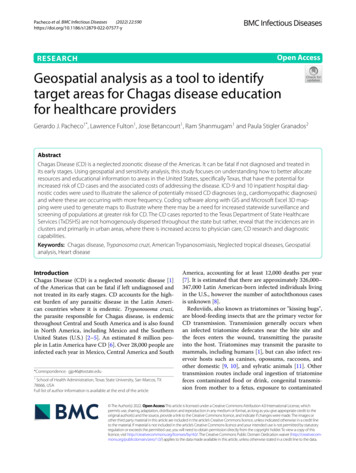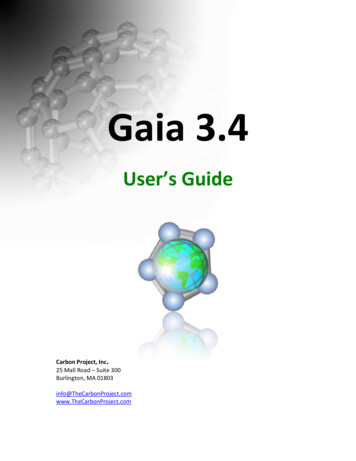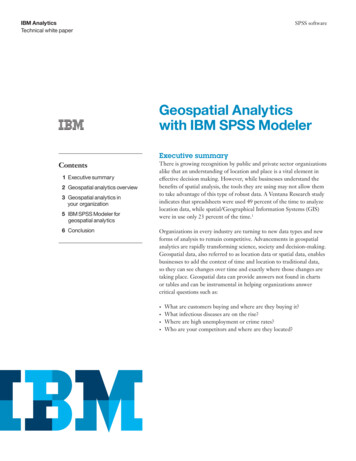
Transcription
(2022) 22:590Pacheco et al. BMC Infectious Open AccessRESEARCHGeospatial analysis as a tool to identifytarget areas for Chagas disease educationfor healthcare providersGerardo J. Pacheco1*, Lawrence Fulton1, Jose Betancourt1, Ram Shanmugam1 and Paula Stigler Granados2AbstractChagas Disease (CD) is a neglected zoonotic disease of the Americas. It can be fatal if not diagnosed and treated inits early stages. Using geospatial and sensitivity analysis, this study focuses on understanding how to better allocateresources and educational information to areas in the United States, specifically Texas, that have the potential forincreased risk of CD cases and the associated costs of addressing the disease. ICD-9 and 10 inpatient hospital diagnostic codes were used to illustrate the salience of potentially missed CD diagnoses (e.g., cardiomyopathic diagnoses)and where these are occurring with more frequency. Coding software along with GIS and Microsoft Excel 3D mapping were used to generate maps to illustrate where there may be a need for increased statewide surveillance andscreening of populations at greater risk for CD. The CD cases reported to the Texas Department of State HealthcareServices (TxDSHS) are not homogenously dispersed throughout the state but rather, reveal that the incidences are inclusters and primarily in urban areas, where there is increased access to physician care, CD research and diagnosticcapabilities.Keywords: Chagas disease, Trypanosoma cruzi, American Trypanosomiasis, Neglected tropical diseases, Geospatialanalysis, Heart diseaseIntroductionChagas Disease (CD) is a neglected zoonotic disease [1]of the Americas that can be fatal if left undiagnosed andnot treated in its early stages. CD accounts for the highest burden of any parasitic disease in the Latin American countries where it is endemic. Trypanosoma cruzi,the parasite responsible for Chagas disease, is endemicthroughout Central and South America and is also foundin North America, including Mexico and the SouthernUnited States (U.S.) [2–5]. An estimated 8 million people in Latin America have CD [6]. Over 28,000 people areinfected each year in Mexico, Central America and South*Correspondence: gjp46@txstate.edu1School of Health Administration, Texas State University, San Marcos, TX78666, USAFull list of author information is available at the end of the articleAmerica, accounting for at least 12,000 deaths per year[7]. It is estimated that there are approximately 326,000–347,000 Latin American-born infected individuals livingin the U.S., however the number of autochthonous casesis unknown [8].Reduviids, also known as triatomines or "kissing bugs",are blood-feeding insects that are the primary vector forCD transmission. Transmission generally occurs whenan infected triatomine defecates near the bite site andthe feces enters the wound, transmitting the parasiteinto the host. Triatomines may transmit the parasite tomammals, including humans [1], but can also infect reservoir hosts such as canines, opossums, raccoons, andother domestic [9, 10], and sylvatic animals [11]. Othertransmission routes include oral ingestion of triatominefeces contaminated food or drink, congenital transmission from mother to a fetus, exposure to contaminated The Author(s) 2022. Open Access This article is licensed under a Creative Commons Attribution 4.0 International License, whichpermits use, sharing, adaptation, distribution and reproduction in any medium or format, as long as you give appropriate credit to theoriginal author(s) and the source, provide a link to the Creative Commons licence, and indicate if changes were made. The images orother third party material in this article are included in the article’s Creative Commons licence, unless indicated otherwise in a credit lineto the material. If material is not included in the article’s Creative Commons licence and your intended use is not permitted by statutoryregulation or exceeds the permitted use, you will need to obtain permission directly from the copyright holder. To view a copy of thislicence, visit http://creativecommons.org/licenses/by/4.0/. The Creative Commons Public Domain Dedication waiver ) applies to the data made available in this article, unless otherwise stated in a credit line to the data.
Pacheco et al. BMC Infectious Diseases(2022) 22:590blood products and through organ transplantation froman infected donor [4]. Blood donation screening is themost common means by which individuals learn abouttheir CD diagnosis in the U.S. [12].CD includes two main phases: acute and chronic [1,13]. Acute infections occur up to the first two monthsof the initial infection, which may manifest with mildflu-like symptoms or prolonged febrile illness [14, 15].Other symptoms may include malaise; enlarged spleen,liver, and lymph nodes; localized or generalized edema;and chagomas or breaks in the skin [1]. Infection mayalso result in abnormal electrocardiogram (ECG) readings [10]. Acute infection may manifest as early as oneweek post- exposure and may be self-limiting in mostindividuals [10]. The patient may not seek medical attention since the symptoms are mild and not unique to CD.During the chronic stage, two presentations are possible:the indeterminate form and determinate form. The indeterminate form is characterized as a chronic infection byT. cruzi without specific organ damage and is commonlyasymptomatic. The determinant form is characterized ashaving specific organ damage with complications, whichmay include cardiac manifestation (e.g., cardiomyopathy,heart failure, altered heart rate or rhythm) and intestinalcomplications [13]. Approximately 70–80% of infectedindividuals [13, 16] will transition from the acute phaseand remain in a latent or indeterminate chronic form ofthe disease (mostly asymptomatic), which may persistas a lifelong infection [4]. The danger of this asymptomatic status is that once symptoms do manifest, eliminating the parasite is either more difficult or impossiblewith the latter case resulting in death. Treatment of thedisease is with anti-parasitic drugs (Benznidazole orNifurtimox) [17]; however research does not conclusivelysuggest a reduction in mortality after treatment nor areversal of symptoms if the patient has entered into thechronic phase with specific organ damage [18]. Approximately 20–30% of infected individuals will progress fromthe indeterminate chronic phase without organ damageto a “clinically evident disease” or chronic determinatephase. This progression occurs months to decades afterbecoming infected [15]. Infection in humans can presentin many forms such as non-ischemic cardiomyopathy,heart failure, cardiac arrhythmias and sometime gastrointestinal disease [10]. Cardiovascular pathophysiology isbelieved to be multi-causal (e.g., direct parasitic aggression [19–22]). Sudden death due to cardiac complicationscan also occur [6]. For the scope of this study, heartrelated symptoms were the primary focus.Chagasic cardiomyopathy may include cardiac arrhythmias, heart failure, and risk of sudden death from ventricular fibrillation or tachycardia or thromboembolicevents [10, 23]. Cardiovascular disease in CD patientsPage 2 of 11is believed to be the result of the presence of the parasite in the cardiac tissue causing an immune-mediatedmyocardial injury [24]. A recent study by Hyson et al.,screened 1156 patients for CD and revealed that out ofthe 23 patients that had positive serological screenings,cardiomyopathy and congestive heart failure was presentin 43% of the cases [25]. CD may present as an idiopathiccardiomyopathy and therefore be overlooked by manyor most healthcare providers as a diagnosis if they areinexperienced in seeing patients with CD. An estimated10–15% of the total U.S. population (or 30,000 to 45,000individuals) is estimated to be living with undiagnosedCD cardiomyopathy [26]. Many U.S. physicians and otherhealthcare providers (HCPs) are not well versed in CDscreening, diagnostics, or treatment [27].Between 2013 and 2019, 184 total cases of CD werereported in Texas [28]. Although regarded typically as arare neglected tropical disease [1], current vector surveillance, [29, 30] the increased frequency of Chagas positiveblood donors, [31–33] and population migration, [34,35] demonstrate why more CD cases may be going undetected in the U.S.With regards to U.S. physicians’ knowledge of CD,recent pre-post evaluation of healthcare providers(HCPs) in Texas suggests specific gaps in medical training and awareness on screening and diagnosing patients[36]. A separate study using a mixed methods approachsupports these findings: HCPs were not confident overallin their skills to screen, diagnose, and treat CD patients[37]. In a recent study of sampled U.S. obstetricians, lessthan one-third of the study sample knew of the testingprotocol, and one fifth knew of the follow-up protocolsonce a patient received a positive diagnosis [38]. Thus,facilitating CD education to healthcare providers remainsa challenge [27, 36].This study aims to illustrate potential heart-relatedCD in Texas using a geospatial and sensitivity analysisto inform health policy makers of the areas where prevention, education and screening efforts might be bestserved. Given the risk factors for exposure and transmission to CD and etiology of specific strains (i.e., heartrelated symptoms), we hypothesize an increased numberof suspected cases of CD throughout the state amongyounger Hispanic individuals. Based on the suspectedcase definitions (described below), we expect a higherproportion of individuals with undiagnosed CD withheart-related symptoms.MethodsData sourcesThe Inpatient Public Use Data File (IPUDF) for 2016,maintained by the Texas Department of State HealthServices (TxDSHS), and the number of Chagas cases
Pacheco et al. BMC Infectious Diseases(2022) 22:590Page 3 of 11confirmed for 2019 by TxDSHS were used for geospatial analysis [39, 40]. In Texas, CD became a reportablecondition in 2013; therefore hospital inpatient data from2013 to 2016 were acquired. In Texas, a CDC confirmeddiagnosis is reported to TxDSHS and is listed as eitheracute, chronic indeterminant or chronic determinantbased on epidemiological investigations and interviewsconducted by the local or regional health departments.Census data [41] was used to download the AmericanCommunity Survey (ACS) 5-year Texas population estimates for 2016. This included Texas demographic dataon age and Hispanic status by county. A base map wascreated by downloading the shapefile for the Texas counties from the U.S. Census Bureau (i.e., TIGER/Line Webinterface) [42].Variables and case definitionsPatient demographics and patient diagnostic codes originated from the inpatient data (i.e., the raw quarterly basefiles from the PUDF, 2013 to 2016). The demographicvariables included: patient’s age group (i.e., 18; 18–44;45–64; 65–74; and 75); ethnicity (Hispanic or non-Hispanic); race (American Indian/ Eskimo; Asian or PacificIslander; Black; White; or Other); and sex code (male orfemale). Additional variables that were kept from the initial raw inpatient PUDF dataset included: record identification number for each hospital admission; patient’scounty and zip code of residence; provider ID; and typeof admission.The admitting diagnosis and the twenty-four principlediagnostic codes were the queried variables from eachquarterly base data file (e.g., IPUDF) for each hospitaladmission. The process was iterative and exploratory inidentifying both the diagnosed CD cases and the potentially missed CD cases (undiagnosed) manifested throughheart complications. These diagnoses variables werere-coded to determine if that particular patient recordcontained the ICD 9 or ICD 10 diagnostic codes of interest (e.g., Table 1: CD cases). A total of 3,088,978 hospital inpatient records were identified once all the datasetswere combined (i.e., 2013–2016). A dichotomous variable (i.e., for any admission that had any of the CD-relatedICD diagnosis codes) was created using the CD cases.A cardiologist with expertise in diagnosing CD wasconsulted with to identify and further review heartrelated diagnostic codes (i.e., the potentially-missed CDcases). The list of ICD codes was then reviewed by a second cardiologist with experience in diagnosing and treating CD patients to eliminate unnecessary codes. The ICDdiagnostic code and corresponding definition for heartrelated cases, a proxy for potentially-missed CD diagnosis, are shown on the second half of Table 1. AdditionalICD-10-CM codes for heart-related diagnoses wereidentified to expand the list of potentially-missed cases(Table 2). The IPUDF transitioned from utilizing ICD-9diagnosis codes to ICD-10 in 2016. Additionally, this wasthe most recent year of available data for the analyses atTable 2 Additional ICD-10 cardiomyopathy codes that could bepotentially related to a missed Chagas disease diagnosisDiagnostic codeDescriptionI428Other cardiomyopathiesI429Cardiomyopathy, unspecifiedI4510Unspecified Right Bundle Branch BlockI452Bifascicular blockI441Atrioventricular block, second degreeI442Atrioventricular block, completeI472Ventricular tachycardiaTable 1 Chagas disease and potential cardiomyopathy-related ICD 9 and ICD 10 codes with descriptionsCaseICD VersionDiagnostic codeDescriptionChagas diseaseICD-9-CM086.0Chagas with heart involvementICD-9-CM086.1Chagas with other organ involvementICD-9-CM086.2Chagas without mention of organ involvementICD-10-CMB57.0Acute, heartICD-10-CMB57.1Acute, without heartICD-10-CMB57.2Chronic, with heartICD-9-CM414.8Other forms of chronic ischemic heart diseaseICD-9-CM422.91Idiopathic myocarditisICD-9-CM425.8Cardiomyopathy, excludes ChagasICD-9-CM425.4Cardiomyopathy, includes idiopathicICD-10-CMI25.5Ischemic cardiomyopathyICD-10-CMI42.9Cardiomyopathy, unspecifiedPotentially missed CD cases (heartrelated codes)
Pacheco et al. BMC Infectious Diseases(2022) 22:590Page 4 of 11the time of the study. The expanded list was only used toquery 2016 to identify the potentially-missed CD cases.A dichotomous variable (i.e., for any admission that hadany of the heart-related ICD diagnosis codes) was createdusing the heart-related ICD codes.Data collection and managementThe 2016 quarterly IPDUF base files were individually exported as a comma separated value file (CSV) toExcel. Exploratory data analysis and data cleaning wereperformed, and patient records that did not contain thecase definitions were eliminated from the dataset. Thecombined raw IPUDF contained over 3 million hospitaladmissions of which 3.1% were included in this study,as they contained a heart related/CD diagnosis code.Demographic data for the state of Texas were downloaded using the American Fact Finder web application.The ACS estimates were chosen for the Hispanic population and age categories. Microsoft Excel was used fordata cleaning. To calculate the Hispanic proportion, thenumber of Hispanics was divided by the total populationfor each county. To create the table for age groups, onlythe population estimates for males, females, and all, aged20–59 were calculated.MappingOnce definitions were finalized, the dichotomousvariables for CD cases and potentially- missed CD(heart-related) were compiled, aggregated by year, andtabulated. ArcMap GIS (Version 10.6.0) was used to visualize the variables [43]. This software coupled with Excel2016’s innate 3d mapping provided geographic descriptive capability. A series of maps were created to exploregeographic areas of interest.ModelingAll but two of the 254 counties in the state were includedin the models. Two of the 254 Texas counties wereexcluded in the models due to low reporting and patientcounty suppression, “The county code is suppressed ifa county has fewer than five discharges for that quarter” [40]. Linear regression with residuals was appliedusing the following variables: male population, Hispanics, race (Asian or Pacific Islander; Black, White, andOther), county population, population density (personsper km2, and rate). The modelling techniques (e.g.,Queen’s, Global Moran’s index, etc.) used can be referenced online: https:// rpubs. com/R- Minat or/ chaga s1.For instance, Moran’s index I captures (Li et al. 2007) theintercorrelation between two adjacent geographic units(counties or towns etc.) with respect to the CD incidence.The expected value of the Moran’s index is 1/(N 1)under the assumption of no geo spatial autocorrelationamong the units. Where N is the number geographical units. An analysis on Global Moran’s I was used toaccount for location and variable differences [44]. Robustlinear mixed-method models with Lagrange multiplierdiagnostics as a way to test for spatial dependence [45]. Ageneralized spatial two-stage least squares model (usingSTSLS) was used. This model with weighted matrixaccounted for variability. The model controlled for gender (males), age, and population.ResultsDescriptive statistics Chagas diagnoses and heart‑relatedICD codesUtilizing the IPDUF database, 98 CD diagnoses between2013 and 2016 were identified. Of these 98 cases, 78 presented with heart involvement and the other 20 werenot specified. There were 366,575 cases that fit the ICD9 or 10 definitions for potentially missed diagnosis (i.e.,heart-related diagnoses). “Cardiomyopathy, includingidiopathic” and “other chronic ischemic heart diseasediagnoses” accounted for the most instances (118,206and 150,207, respectively). The least occurring diagnostic code was for idiopathic cardiomyopathy (n 384).Table 3 provides the descriptive statistics for the ICDrelated data: total CD diagnoses and suspected (i.e.,heart-related conditions).The data for the suspected cases (i.e., potentiallymissed CD cases) were zero-inflated. Of the 254 counties, only 15 were non-zero. The average number of CDcases in any county was 0.39, and the median was 0. Themaximum number of confirmed CD inpatient cases was26 (Dallas County). For total heart-related diagnoses(i.e., potentially missed CD), only 1 observation had zerocases (Loving County). The mean was 1443 cases witha median of 340.5 (large positive skewness). Within oursample, 49% were male and 39% were Hispanic. The largest Hispanic population resided in Starr County (99%).Table 3 Descriptive statistics for Chagas disease cases and potentially missed Chagas disease cases using the ICD-related data frominpatient hospital records in Texas, 2013–2016CountiesCD casesMeanSD2540.392.46Potentially Missed CD cases (i.e., Heart- 254Related 0.5059,118366,575
Pacheco et al. BMC Infectious Diseases(2022) 22:590The smallest Hispanic population resided in RobertsCounty (3%). The median age was 34 years old.MapsFigure 1 illustrates the number of CD cases reported toTxDSHS between 2013 and 2016 in Texas, by transmission type as confirmed by the Zoonosis Control Division. This map provides a baseline for understandinggeographic concentrations of confirmed cases of CD asreported by TxDSHS. A total of 91 individual cases wereconfirmed and reported, with each corresponding symbol representing a case. Based on the data presented inthis figure, the largest clusters of imported cases were inHarris and Dallas counties. Individual imported caseswere reported in Potter and Wilbarger counties in thenorth, El Paso in the far west, and Shelby and Andersoncounties towards the east. Locally acquired cases werereported in Bexar County and some in South Texas counties of Hidalgo, Brooks, and Cameron. It should be notedthat it is possible that locally-acquired cases could becongenital transmission. However, there is research andsurveillance that indicates positive triatomines in SouthPage 5 of 11Texas have been frequently found near human dwellings,therefore autochthonous transmission is plausible [4, 46,47].Figure 2 is a heat map of the ICD codes for heartrelated diagnosis (i.e., potentially missed CD cases). Theheat map provides color-changing values that indicateintensity levels of the disease processes (blue being theleast intense and red being the most). From the map, it isclear that Houston has the most coded cases with Dallas,Fort Worth, and San Antonio ranking 2nd through 4th,respectively.Figure 3 represents the ACS estimate of the Hispanicpopulation. A graduated symbology (i.e., red triangles) isshown in both maps to illustrate the potential for missedCD disease diagnosis (displayed as the CD heart relateddiagnostic codes) given that a younger population mightbe experiencing heart complications. Counties with ahigh Hispanic population (75% to 99%) had a range ofheart-related frequency, though the highest numberswere in El Paso, Maverick, Webb, Hidalgo, and Cameron.Counties with a lower proportion of a Hispanic population such as Randall or Montgomery had large (but notFig. 1 Chagas disease cases and transmission categories reported by the Texas Department of State Health Services by county of transmission from2013 to 2016
Pacheco et al. BMC Infectious Diseases(2022) 22:590Page 6 of 11Fig. 2 Heat map of ICD heart related codes that could be a possible missed Chagas disease diagnosis, 2013–2016the highest) numbers of possible CD heart-related diagnostic codes. The increase in the triangle symbology inthe population map can be seen in some counties with alarge proportion of the population aged 20 to 59. In sixcounties with the largest proportion 55% to 65% in thisage group (i.e., Hartley, Childress, King, Garza, Sterling,and Concho) had 100 or less heart-related diagnosticcodes.Figure 4 shows the comparison between the CD diagnostic codes and the heat map for the number of heartrelated codes. Harris and Dallas/Tarrant, Travis, Bexar,and Cameron counties show clusters of both ICD-codedCD and higher proportions of heart-related diagnosticcodes. Wilbarger County near the Texas-Oklahoma border, a county with 28% Hispanic population, experiencedsix CD diagnoses yet only 345 heart-related codes.Statistical modelingThe mean number of total missed diagnoses was 347.6with a SD of 1158. The descriptive statistics are presentedin Table 4 for the additional variables. The first model(LM) resulted with an f statistic of 2.93, a coefficientdetermination of 0.07755 and a statistical significance(p-value 0.05). An interactive map (https:// rpubs. com/R- Minat or/ chaga s1) was created using the model thatshows the suspected rate (i.e., missed non-ICD Chagasdiagnosis) per 100,000 of the county population.DiscussionInterestingly, the findings in Fig. 4 are congruent with aprevious study of Texas Blood donors, highlighting significant localities of concern [33].CD is more prevalentamong individuals who have lived in endemic regions ofLatin America and are considered to be at a higher riskfor CD. However, it is estimated that only about 1% ofthe individuals living with CD in the U.S. are aware oftheir diagnosis [48]. In our study, heart disease symptoms that are common for patients with CD are used asa proxy to estimate possible cases and indicate areas toincrease screening efforts. Areas in Texas with younger
Pacheco et al. BMC Infectious Diseases(2022) 22:590Page 7 of 11Fig. 3 Potentially missed Chagas disease cases using heart-related ICD diagnosis codes from 2013 to 2016 and Hispanic population in Texas 2016Hispanic populations and increased persons presentingwith heart disease that could be related to CD was thefocus of this paper [33]. It should be noted that this is notthe only population at risk in Texas, however they are ata higher risk than other populations [48]. Presenting datain a visual and spatial format can often be useful in illustrating and contextualizing environmental factors [49].Given that the CD vector is found throughout the Stateof Texas [50], local transmission is not well understoodand the large Hispanic population of Texas, visualizationof potential missed diagnoses is an important and significant exploratory analysis. In turn, through GIS analysisand data visualization, educational and outreach effortscan be further targeted throughout the state. The application of contextualizing maps and integrating with statistical methods to enhance public health activities has beendescribed in chronic diseases [51]. However, the valueand use of GIS to inform public health education activities on CD has not been previously studied.The CD cases reported to TxDSHS are not homogenously dispersed throughout the state but occur inclusters and primarily in urban areas, where presumably there is increased access to physician care and largerpopulations. The policy implication is that screening forCD should begin with the populations most likely at risk[48, 52]. The data from TxDSHS [40] show the possibility for locally acquired or imported infection. Pocketsof locally acquired cases were reported specifically inBexar, Hidalgo, Brooks, and Cameron counties. However, no other areas, (i.e., the panhandle; western Texasincluding the El Paso region; and the eastern parts) showlocally acquired infections. Moreover, five newly diagnosed CD patients are described in a case report [29]: Allof the patients acquired CD locally and resided in ruralSoutheast Texas counties. This highlights the possibility of persons currently not knowing that they have CDbecause many cases remain undiagnosed, particularlysince the disease can become latent. In addition to localtransmission, Texas presents the opportunity to surveiland diagnose imported cases. It is imperative for HCP’sthroughout the state to recognize CD and be able toscreen and diagnose patients.Some counties with a high burden of heart-relateddiagnosis are also areas with CD diagnosis. The congruence in the urban hubs (Bexar, Dallas, and Harris counties) reflects the overall population but may also reflect
Pacheco et al. BMC Infectious Diseases(2022) 22:590Page 8 of 11Fig. 4 Heat map of Chagas disease diagnostic codes and heart-related ICD diagnostics codes combined for 2013–2016Table 4 County-level descriptive statistics for linear model of possible missed diagnosis of Chagas disease in .873394.257159.947385.60735.8681166.667Mean ageNon-HispanicAsian/Pacific IslanderPopulationPopKM2Ratethe availability and ability of physicians in those counties to recognize CD and appropriately screen, diagnose,and treat. Conversely the modeling provided new insightinto geographic areas (i.e., Kenedy County that was notbelieved by the researchers to be an area if interest).More focused education and outreach could be targetedto healthcare providers who may have limited knowledgein screening and diagnosis of CD in geographic areaswhere we find that there could be a higher risk for CD12,983.000along with noted elevations in heart disease among ahigher population of Latinos. As of 2017, the estimatedseroprevalence of CD in Mexico was 2.26%, much higherthan previously thought [29]. A study in Starr County,Texas which lies adjacent to the Mexican border foundthat eight of 1196 study participants (0.7%) screened positive with 2 of the cases 1196 (0.2%) confirmed by studycriteria [53]. With Texas and Mexico sharing such a largeborder region, it stands to reason that the seroprevalence
Pacheco et al. BMC Infectious Diseases(2022) 22:590in places such as Texas could be higher, however withlimited surveillance and screening it is hard to know thetrue amount of CD in Texas or the U.S.LimitationsThis research is one of a few examining CD through hospital records [53]. This is the first to examine statewidehospital records in order to qualify the potential formissed CD diagnosis in Texas. However, this researchfocused on potentially-missed diagnosed cases of chronicChagas, rather than including acute and indeterminatechronic forms of CD. Moreover, in examining chronicCD, the scope of this research was limited to CCC, ratherthan looking at other sequelae (i.e., gastrointestinal complications). Furthermore, establishing the criteria formissed diagnoses of CD was the greatest challenge, giventhe lack of research to inform specific risk factors thataccount for CCC. Thus, the risk of misclassification is aconcern.Inpatient records were exclusively used, rather thanincluding outpatient records given that CD patients donot necessarily require a hospitalization to be diagnosed.CD patients may be unaware of their CD status since thedisease is asymptomatic. Because the patients are asymptomatic, they may be undiagnosed and thus not receiving appropriate care. Finally, the IPUDF data set does notprovide unique patients, rather enumerates the records.Ultimately, this highlights the under-estimation of turmissed diagnoses of CD in Texas.ICD-9 and ICD-10 heart-related and CD diagnosticcodes were not completely comparable given differencesin their definitions. While ICD-10 denotes the diseaseprogression (i.e., acute, or chronic), there is no code specifying the indeterminate form of CD. In ICD-9 there is acode (086.2) that alludes to the asymptomatic, indeterminate form (i.e., Chagas without mention or organ involvement). Similarly, among the heart-related diagnostics,there is a cardiomyopathy, excluding Chagas in ICD-9code but not one for ICD-10. Between 2013 and Augustof 2015, a total of 21 records indicated Chagas withoutmention of organ involvement. Furthermore, ICD codesare intended for medical billing and are not confirmedCD diagnosis. The identified barriers [55] to screeningand diagnosing acute a
ICD-9-CM 414.8 Other forms of chronic ischemic heart disease ICD-9-CM 422.91 Idiopathic myocarditis ICD-9-CM 425.8 Cardiomyopathy, excludes Chagas ICD-9-CM 425.4 Cardiomyopathy, includes idiopathic ICD-10-CM I25.5 Ischemic cardiomyopathy ICD-10-CM I42.9 Cardiomyopathy, unspecied Table 2 Additional ICD-10 cardiomyopathy codes that could be .











